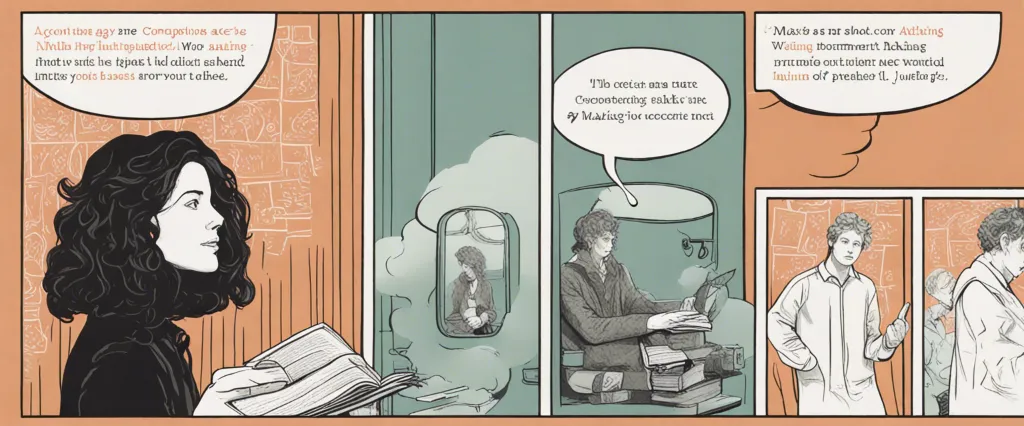Come as You Are is an enlightening exploration of the science behind female sexuality. With invaluable insights and evidence-based research, Nagoski challenges common misconceptions and sheds light on the complexities of women’s desire and arousal. By debunking myths and presenting a comprehensive understanding of sexual well-being, the author offers women the tools to embrace their unique sexual selves. Emily Nagoski is a renowned sex educator and researcher who holds a PhD in Health Behavior with a focus on women’s sexual wellbeing. Through her work, Nagoski aims to empower all individuals to discover and embrace their own sexual potential, free from societal judgments and expectations.
Chapter 1: Understanding Your Sexual Self
Chapter 1 of “Come As You Are” by Emily Nagoski, titled “Understanding Your Sexual Self,” explores the various factors that shape an individual’s sexuality. Nagoski highlights the importance of understanding one’s own unique sexual response system while debunking common myths and misconceptions surrounding sexuality.
Nagoski introduces the Dual Control Model (DCM) as a framework for understanding sexual desire and responsiveness. According to the DCM, sexual response is a combination of both Accelerators (things that push the sexual “gas pedal”) and Brakes (things that apply the sexual “brake”). These factors can vary from person to person, and understanding them is crucial for developing a healthy sexual self.
The chapter emphasizes the vast range of normal sexual experiences and challenges the notion that there is a single, ideal sexual response. Nagoski addresses the negative impacts of societal and cultural expectations on individuals’ sexual experiences, highlighting that everyone’s sexuality is unique and valid.
Furthermore, Nagoski examines common myths surrounding sexual desire, such as the belief that women have lower sexual desire than men or that desire should naturally be spontaneous. She offers an alternative perspective, suggesting that desire often emerges from arousal and that context plays a significant role in shaping desire.
Finally, the chapter concludes by presenting the idea that embracing one’s own unique sexual response system, free from societal expectations or comparisons, is vital for developing a healthy and fulfilling sexual well-being.
In summary, Chapter 1 of “Come As You Are” provides an in-depth exploration of understanding one’s sexual self. Nagoski encourages readers to recognize the multidimensional nature of desire and emphasizes the importance of personal acceptance and understanding in fostering a healthy and satisfying sexual life.
Chapter 2: Exploring the Science of Sexual Response
Chapter 2 of “Come as You Are” by Emily Nagoski delves into the science behind sexual response, seeking to answer the age-old question: How does our body respond to sexual stimulation? Nagoski aims to debunk the pervasive myths surrounding sexual response and provide readers with a comprehensive understanding of their own unique sexual blueprint.
The chapter begins by introducing the dual control model, which asserts that our sexual response is governed by two systems: the “accelerator” and “brakes.” The accelerator corresponds to the sexual response system, which is activated by erotic stimuli, while the brakes represent anything that inhibits or diminishes sexual response. Every individual’s accelerator and brakes operate differently, and understanding these systems is crucial to enhancing sexual pleasure and satisfaction.
Nagoski then discusses how sexual response is influenced by the interplay of various physical, cognitive, and environmental factors. She explores the concept of sexual excitation and inhibition, with excitation being the physiological arousal and desire for sexual activity, and inhibition representing any internal or external factors that dampen that desire. These factors can range from stress, sexual inhibition due to cultural or religious beliefs, body image issues, or even trauma.
Throughout the chapter, narratives and case studies are interwoven to illustrate the complexity and diversity of sexual response. Nagoski emphasizes the importance of embracing individual differences and personalizing sexual experiences, as there is no one-size-fits-all approach to pleasure. Key takeaways include the understanding that sexual response occurs on a spectrum, that it is influenced by a multitude of factors, and that embracing the uniqueness of one’s own body and desires is key to achieving satisfaction.
In summary, Chapter 2 of “Come as You Are” delves into the scientific intricacies of sexual response while busting prevalent myths. By understanding the dual control model, sexual excitation and inhibition, and the role of individual differences, readers gain valuable insights into their own sexuality, setting the stage for personal growth and sexual fulfillment.
Chapter 3: Embracing Your Unique Sexual Wiring
Chapter 3 of “Come as You Are” by Emily Nagoski, titled “Embracing Your Unique Sexual Wiring,” explores the concept of sexual concordance and how individuals can understand and accept their own sexual desires and preferences.
Nagoski begins by explaining that sexual concordance refers to the alignment between genital response and subjective sexual arousal. In other words, it is the matching of how our genitals physically respond to sexual stimuli and how aroused we feel mentally and emotionally. She emphasizes that low sexual concordance does not signify brokenness or dysfunction but rather highlights the natural variation in human sexuality.
The chapter delves into the framework of dual control systems: the sexual excitation system (SES) and the sexual inhibition system (SIS). The SES is responsible for initiating sexual desire and arousal, while the SIS acts as a brake on our intimate experiences. Nagoski discusses how these systems differ for individuals, leading to variations in people’s responses to sexual stimulation.
The author also incorporates the concept of “accelerators” and “brakes” to better understand sexual response. Accelerators are triggers or stimuli that turn us on, while brakes are factors that inhibit or diminish our arousal. Nagoski emphasizes that understanding and acknowledging these accelerators and brakes within ourselves is crucial for embracing our unique sexual wiring.
Throughout the chapter, Nagoski emphasizes the importance of self-compassion and self-acceptance when it comes to one’s own sexual desires and preferences. By recognizing that our sexual wiring is a product of both biological and personal factors, individuals can begin to appreciate their own unique needs and experiences.
In summary, Chapter 3 of “Come as You Are” explores the idea of sexual concordance and the dual control systems that influence our sexual responses. By understanding and appreciating our own unique sexual wiring, we can cultivate self-acceptance and navigate our personal desires and boundaries with compassion and confidence.
Chapter 4: Navigating Sexual Arousal and Desire

Chapter 4 of “Come as You Are” by Emily Nagoski, titled “Navigating Sexual Arousal and Desire,” explores the complex nature of sexual response and how understanding it can contribute to a healthier and more fulfilling sex life.
The chapter begins by explaining the dual control model of sexual response, which suggests that sexual arousal and desire are influenced by two distinct systems: the sexual inhibition system (SIS) and the sexual excitation system (SES). The SIS acts as a sexual brake, responding to potential threats or stressors and inhibiting sexual arousal. On the other hand, the SES serves as a sexual accelerator, responding to arousing stimuli and promoting sexual desire.
Nagoski introduces the concept of an “accelerator” and “brake” to help readers understand their own unique response patterns. She explains that individuals vary in what triggers their accelerators and brakes, and understanding these factors is vital for effective communication and sexual satisfaction in relationships.
The author highlights the importance of context in understanding sexual desire. She explains that desire is not a constant state but rather a responsive process that is influenced by various external and internal factors. These can include stress, self-image, relationship dynamics, and personal beliefs about sexuality. Nagoski emphasizes the fluidity and variability of desire, challenging the common misconception that desire should always be spontaneous.
To help readers better identify their sexual accelerators and brakes, Nagoski offers various exercises and encourages self-reflection. She discusses the significance of understanding one’s own sexual context, exploring individual fantasies, and recognizing the role of non-sexual experiences in shaping desire and arousal.
In summary, Chapter 4 of “Come as You Are” provides valuable insights into the dynamic nature of sexual arousal and desire. By examining the interplay between accelerators and brakes, understanding the influence of context, and promoting open communication, individuals can create a more fulfilling and satisfying sexual experience.
Chapter 5: Overcoming Sexual Challenges and Obstacles
Chapter 5 of “Come as You Are” by Emily Nagoski focuses on overcoming sexual challenges and obstacles. The chapter delves into various aspects that can impact an individual’s sexual satisfaction. Nagoski emphasizes the importance of understanding and accepting that everyone’s sexuality is unique and that there is no “right” way to experience or enjoy sex.
The chapter begins by addressing the concept of sexual arousal and how it can be influenced by a person’s context and environment. Nagoski highlights that crucial aspects such as stress, anxiety, and emotional well-being can greatly impact sexual desire. She encourages individuals to explore their own experiences and identify the factors that enhance or hinder their sexual pleasure.
Another significant topic discussed in this chapter is the impact of societal expectations and cultural norms on sexual experiences. Nagoski acknowledges that various external factors, such as body image pressures and societal messages surrounding sex, can contribute to feelings of shame and dissatisfaction. She guides readers toward self-compassion and decreasing self-judgment to cultivate a healthier and more positive sexual self-image.
Nagoski also delves into the importance of communication and consent in sexual relationships. She emphasizes the value of open and honest conversations about desires, boundaries, and preferences. Nagoski suggests that building trust and fostering intimacy can enhance sexual satisfaction and address potential challenges.
Furthermore, the chapter explores common sexual challenges such as pain during intercourse, low libido, and difficulties reaching orgasm. Nagoski emphasizes the need to approach these challenges with patience, understanding, and a focus on pleasure rather than performance. She provides practical suggestions and strategies to overcome these obstacles, acknowledging that seeking professional help or therapy may be beneficial in some cases.
Overall, Chapter 5 of “Come as You Are” seeks to empower individuals to overcome sexual challenges by fostering self-acceptance, open communication, and a focus on pleasure. It encourages readers to embrace their unique sexual selves and find strategies that work best for them to enhance their sexual satisfaction.
Chapter 6: Cultivating Sexual Confidence and Body Positivity
In Chapter 6 of “Come as You Are” by Emily Nagoski, titled “Cultivating Sexual Confidence and Body Positivity,” the author focuses on helping individuals develop a healthy mindset and positive relationship with their bodies to enhance sexual well-being.
Nagoski starts by emphasizing the importance of self-compassion and self-acceptance. She encourages readers to view their bodies as a source of pleasure and to let go of societal standards that perpetuate negative body image. The author highlights the idea that body positivity is not about eradicating all negative thoughts, but rather about recognizing these thoughts and reframing them with self-compassion.
Nagoski suggests adopting a holistic approach to body positivity by focusing on self-care, which involves taking care of one’s physical and emotional well-being. Engaging in activities that promote self-care, such as regular exercise, practicing mindfulness, and prioritizing sleep, can contribute to an overall positive body image and sexual confidence.
Another important aspect discussed is the impact of our social environment on body positivity. Nagoski emphasizes the need to surround ourselves with positive influences and to distance ourselves from situations or people that perpetuate negative body image ideals. Building a supportive community and engaging in open conversations about body image and sexuality can contribute to a healthier mindset.
Moreover, the author emphasizes the significance of understanding personal sexual preferences and desires and communicating them effectively with partners. This plays a vital role in cultivating sexual confidence. Encouraging open dialogue, consent, and mutual understanding create an environment where sexual exploration and satisfaction can flourish.
In concluding the chapter, Nagoski reminds readers that body positivity is a journey that requires ongoing effort and self-reflection. By embracing compassion, focusing on self-care, and fostering open dialogue, individuals can cultivate sexual confidence and body positivity, enhancing their overall well-being and connection with their own bodies.
Chapter 7: Enhancing Intimacy and Connection
Chapter 7 of the book “Come as You Are” by Emily Nagoski is titled “Enhancing Intimacy and Connection.” In this chapter, Nagoski explores various factors that can contribute to creating a strong emotional bond and deepening intimacy within relationships.
Nagoski emphasizes the importance of communication in fostering intimate connections between partners. She encourages individuals to express their desires and needs openly, as well as to actively listen and show understanding to their partner’s wants and boundaries. By developing effective communication skills, couples can build trust, increase emotional connection, and navigate potential conflicts more effectively.
The author also delves into the concept of vulnerability and its role in intimacy. Nagoski explains that allowing oneself to be vulnerable with a partner can deepen emotional intimacy and foster a sense of closeness. By creating a safe space where both partners feel comfortable expressing their true selves and sharing their deepest thoughts and feelings, couples can strengthen their connection and build a solid foundation for a satisfying sexual relationship.
In addition to communication and vulnerability, Nagoski emphasizes the importance of exploring mutual interests and activities together. Engaging in shared hobbies, experiencing new adventures, or simply spending quality time together helps create a bond beyond just sexual intimacy. These shared experiences enhance emotional connection and foster a sense of togetherness.
The chapter also discusses the significance of physical touch and affection in promoting intimacy. Nagoski explains that different forms of touch, from tender gestures like holding hands to more passionate acts, can contribute to the overall intimacy and connection between partners. Recognizing and appreciating one another’s unique preferences and boundaries in terms of physical touch plays a vital role in ensuring the comfort and satisfaction of both partners.
Overall, Chapter 7 of “Come as You Are” highlights the importance of effective communication, vulnerability, shared experiences, and physical affection in enhancing intimacy and connection within relationships. It offers valuable insights and practical advice for individuals seeking to deepen their emotional bond and create fulfilling partnerships.

Chapter 8: Embracing Pleasure and Joyful Sexuality
Chapter 8 of “Come as You Are” by Emily Nagoski is titled “Embracing Pleasure and Joyful Sexuality.” In this chapter, Nagoski explores the topics of sexual pleasure, desire, and joyful sexuality.
Nagoski begins by emphasizing the importance of understanding that pleasure is the foundation of sexuality. She discusses the concept of “yes, no, maybe” as a way to navigate desires and boundaries within sexual experiences. Identifying individual preferences and communicating them with a partner is crucial to achieving mutual pleasure.
The author delves into the concepts of spontaneous and responsive desire, debunking the myth that sexual desire should always be spontaneous. Instead, Nagoski emphasizes that for many individuals, desire may emerge during a sexual encounter rather than being present beforehand. Recognizing and embracing responsive desire can lead to a more satisfying sexual experience.
Nagoski then explores the role of context in sexual pleasure. Factors such as stress, feeling safe, and cultivating a positive sexual self-image greatly impact one’s ability to experience pleasure. Dismissing societal expectations and embracing one’s authentic self is crucial in fostering joy and pleasure in sexuality.
Furthermore, the author highlights the significance of consent and enthusiastic consent. Consent should be an active and ongoing process, where all parties involved are comfortable and enthusiastic about the sexual activity.
In summary, Chapter 8 of “Come as You Are” focuses on the importance of pleasurable and joyful sexuality. It emphasizes the need for understanding personal desires, exploring responsive desire, and recognizing the role of context in sexual experiences. By embracing pleasure and fostering a positive sexual self-image, individuals can cultivate a fulfilling and satisfying sexual life.
After Reading
In conclusion, Emily Nagoski’s book “Come as You Are” offers a refreshing and empowering perspective on female sexuality. By debunking myths and breaking down cultural barriers, Nagoski helps women understand and embrace their own unique desires, pleasures, and experiences. With a compassionate and informative approach, the book encourages self-acceptance, communication, and exploration. By providing valuable insights and practical advice, Nagoski empowers women to fully embrace their sexuality and create fulfilling, satisfying, and authentic sexual lives. “Come as You Are” is an essential read for any woman seeking to understand, embrace, and celebrate her own unique sexuality.
1. “The Multi-Orgasmic Woman: Discover Your Full Desire, Pleasure, and Vitality” by Mantak Chia and Rachel Carlton Abrams – This book explores female sexuality and provides practical advice on achieving multiple orgasms, enhancing sexual energy, and cultivating a fulfilling and satisfying sex life.
2. “Sexual Intelligence: What We Really Want from Sex and How to Get It” by Marty Klein – In this book, Marty Klein, a renowned sex therapist, offers valuable insights into our societal attitudes towards sex and provides practical advice on how to enhance sexual satisfaction and improve intimacy in relationships.
3. “Becoming Cliterate: Why Orgasm Equality Matters – And How to Get It” by Laurie Mintz – Laurie Mintz addresses the orgasm gap between men and women, demystifying female sexuality and offering practical tips on how to increase pleasure and communicate desires in a sexual relationship.
4. “Come Hither: A Commonsense Guide to Kinky Sex” by Gloria G. Brame – This book explores the world of BDSM and kinky sex, providing a comprehensive guide for beginners and seasoned enthusiasts alike. It offers practical advice on communication, consent, and exploration of various kinks, while promoting a safe and fulfilling sexual experience.
5. “Sex at Dawn: How We Mate, Why We Stray, and What It Means for Modern Relationships” by Christopher Ryan and Cacilda Jethá – This eye-opening exploration of human sexuality challenges conventional beliefs about monogamy and suggests that non-traditional relationship models might be better suited to our primal instincts. It delves into evolutionary biology, anthropology, and psychology to shed light on the complexities of human sexual behavior.




